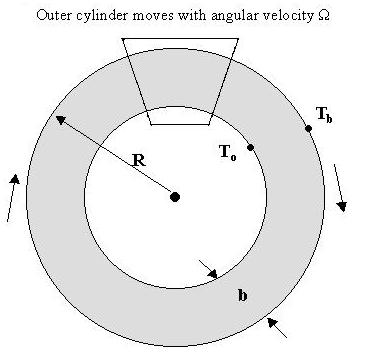
Section 9.4:
Heat Conduction with a Viscous Heat Source
Given in this section are two coaxial cylinders with an incompressible Newtonian fluid between them. The outer cylinder is rotating while the inner cylinder is stationary. The rubbing together of the adjacent layers of the fluid, which is caused by the initial rotation of the outer cylinder, produces heat.
Figure 1. The trapezoidal area has been cut out and enlarged in Figure 2.

Figure 2. Curvature of the cylinders has been neglected.

Sample Problem: Maximum Temperature
A fluid is between two cylindrical cylinders such as those shown in Fig 1. The angular velocity of the outer cylinder is 8097 rpm. The outer cylinder has a radius of 6.05 cm and the distance between the cylinders is 0.072 cm. What is the maximum temperature in the fluid if both wall temperatures are at 158° F? The fluid has a viscosity of 92.3 cp and a thermal conductivity of 0.0055 cal sec-¹ cm-¹ °C-¹
Example 10.5-1:
Temperature Distribution using Cylindrical Coordinates
This example follows Section 9.4 Figure 1. However, in this example the curvature of the coaxial cylinders is not neglected as is shown in Figure 2.
Engineering Applications:
Viscous heating effects in which large velocity changes occur over short distances are important in several problems faced by engineers. Examples include flow of a lubricant between fast-moving parts, the forcing of a polymer through a die (narrow opening) to form a continous sheet, filament or tube and flow of air in the boundary layer when a rocket re-enters the earth's atmosphere.